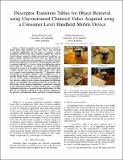Descriptor transition tables for object retrieval using unconstrained cluttered video acquired using a consumer level handheld mobile device
Abstract
Visual recognition and vision based retrieval of objects from large databases are tasks with a wide spectrum of potential applications. In this paper we propose a novel recognition method from video sequences suitable for retrieval from databases acquired in highly unconstrained conditions e.g. using a mobile consumer-level device such as a phone. On the lowest level, we represent each sequence as a 3D mesh of densely packed local appearance descriptors. While image plane geometry is captured implicitly by a large overlap of neighbouring regions from which the descriptors are extracted, 3D information is extracted by means of a descriptor transition table, learnt from a single sequence for each known gallery object. These allow us to connect local descriptors along the 3rd dimension (which corresponds to viewpoint changes), thus resulting in a set of variable length Markov chains for each video. The matching of two sets of such chains is formulated as a statistical hypothesis test, whereby a subset of each is chosen to maximize the likelihood that the corresponding video sequences show the same object. The effectiveness of the proposed algorithm is empirically evaluated on the Amsterdam Library of Object Images and a new highly challenging video data set acquired using a mobile phone. On both data sets our method is shown to be successful in recognition in the presence of background clutter and large viewpoint changes.
Citation
Rieutort-Louis , W & Arandelovic , O 2016 , Descriptor transition tables for object retrieval using unconstrained cluttered video acquired using a consumer level handheld mobile device . in 2016 International Joint Conference on Neural Networks (IJCNN) . , 7727584 , IEEE , pp. 3030-3037 , IEEE World Congress on Computational Intelligence , Vancouver , Canada , 24/07/16 . https://doi.org/10.1109/IJCNN.2016.7727584 conference
Publication
2016 International Joint Conference on Neural Networks (IJCNN)
Type
Conference item
Rights
© 2016, IEEE. This work is made available online in accordance with the publisher’s policies. This is the author created, accepted version manuscript following peer review and may differ slightly from the final published version. The final published version of this work is available at ieeexplore.ieee.org / https://dx.doi.org/10.1109/IJCNN.2016.7727584
Items in the St Andrews Research Repository are protected by copyright, with all rights reserved, unless otherwise indicated.

